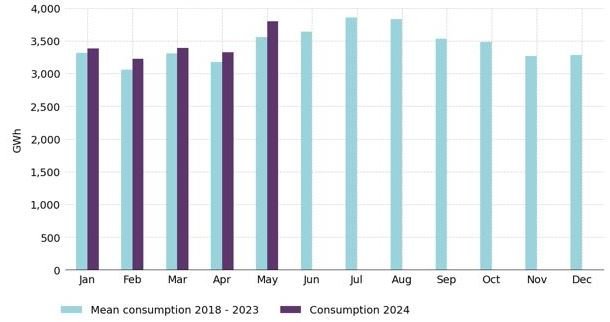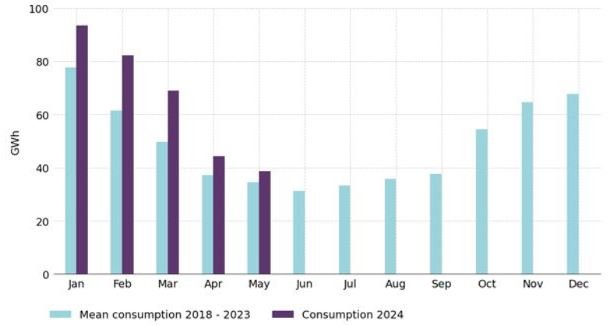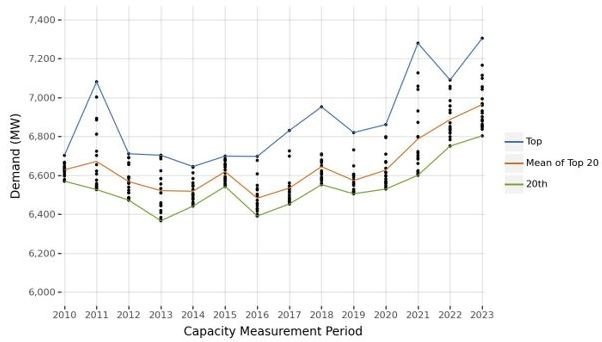Eye on electricity
Why was electricity demand high during 2024?
- Consumers
- Generation
Demand for electricity comes from all over Aotearoa and includes everything from heating homes to smelting aluminum. In 2024, the monthly total electricity demand was higher than the 2019-23 average from January to May and July, as shown in Figure 1. This article explores the different factors behind the higher electricity demand during 2024, including seasonal temperatures, dry weather increasing the need for irrigation, electrification of the economy and growing peak demand.

A warm summer and cool autumn drove up demand for cooling and heating
Temperature greatly impacts electricity demand. High temperatures in summer can increase usage of air conditioning, while cold temperatures in autumn and winter increase demand for heating.
In 2024, New Zealand had both a dry hot summer and a cool autumn, which likely increased electricity demand first for cooling, then heating.
January was a warm dry month, with the nationwide average temperature 1.3 degrees above the 1991-2020 average. Rainfall was also largely below normal (<50% of normal) across most of the country, except in the eastern North Island and western South Island.
February was similar to January, but average temperatures were slightly below average. However, the dryness continued, with many regions experiencing over 20 consecutive days of less than 1mm of rain.
Next came the coolest March in over 10 years and a dry start to autumn. There was some significant rain in mid-April, but mostly in western areas. Then New Zealand experienced the coolest May in 15 years.
Winter 2024 was drier than usual which caused a lot of high-priced thermal generation to run. Also, demand was reduced at some industrial sites, sometimes because of contracts in place allowing this, and sometimes to avoid the high prices. Winter was also mild with above average temperatures (0.9-1.1 degrees above the 1991-2020 average) and apart from July, demand was generally below the historic average. There was no significant rainfall until mid to late September.
Dryness increased electricity demand from irrigation
When weather conditions are dry, some farmers use irrigation to keep their crops healthy. Irrigation uses electricity to power the movement of water and is mostly used between September and April in New Zealand.
The dry start to 2024 saw additional irrigation needed in the Canterbury region, which increased electricity demand. Figure 2 shows the monthly 2024 load at the Ashburton node, which gives a good indication of electricity demand for Canterbury irrigation. This continued to be the case for most of the year. The only months that saw lower consumption at Ashburton were September and October. This was likely due to some high rainfall in September reducing the need for irrigation.

The electrification of homes and industry continues to grow
Some of the increase in electricity demand this year may be from the continued electrification. For example, more kiwis have opted for heat pumps and electric vehicles. Also, various industrial processes have been electrified, with businesses switching from coal to electric boilers. EECA’s regional heat demand database shows many of Aotearoa’s industrial electrification projects.
Peak demand keeps hitting new heights
The demand for electricity peaks in the mornings and evenings and the electricity system is built to handle these peaks. Over the past few years, peak demand has hit new heights and has generally grown each year, especially since 2019, see the orange line in Figure 3.

To meet electricity demand growth additional generation is being built. In January 2024 the Electricity Authority Te Mana Hiko released the results from its generation investment survey which found that in the last 18 months New Zealand had almost doubled the amount of new renewable generation committed to be built.
Covid years may be impacting the comparisons
Lastly, these comparisons are between 2024 and 2019-23 data, so this includes years where electricity demand was impacted by Covid-19 lockdowns and cyclones. So higher demand this year may be due to reductions in demand from events in previous years.
The causes of higher demand in 2024 is complex
In summary, several different factors may be behind the higher demand seen in 2024. These include higher demand from both heating and cooling, additional demand from irrigation as dry conditions persisted and further demand from the electrification of transport, industrial processes and homes.
There has also been strong growth in peak demand, and the electricity industry is responding by building additional generation to meet this demand. However, there have also been events in the last few years which have suppressed electricity demand, so making any definitive statements on why demand is higher in 2024 is tricky at this stage.
Additional monitoring of electricity demand by the Authority will allow us to further understand the drivers behind these differences. This understanding will be built into future and ongoing policy work as the Authority adjusts market settings as the industry moves towards a highly renewable future.
Related News
Consultation opens on 2026/27 levy-funded appropriations
We're consulting on our funding plans for the year ahead and welcome your feedback.
Consumer insights helping to shape the Electricity Authority’s work
The Electricity Authority's 2025 Consumer Perceptions and Sentiment Survey shows that affordability remains a pressing concern for New Zealanders and reinforce…
Summary of digitalisation workshop feedback
The Electricity Authority held a series of workshops during September to discuss what’s needed to help New Zealand transition to a more digital electricity…